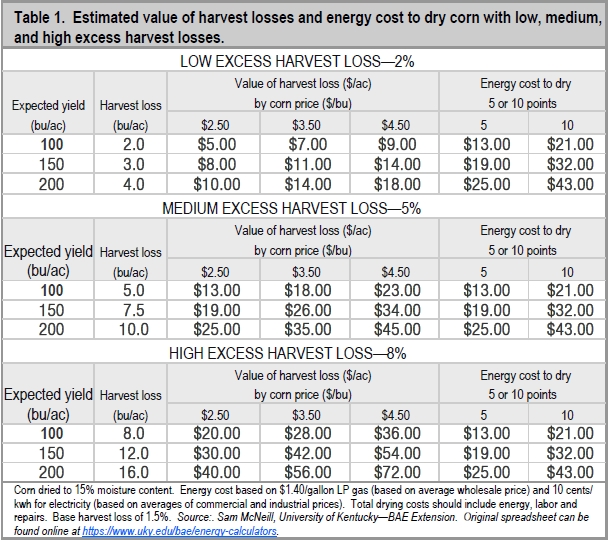- A timely harvest is critical to minimize corn and soybean harvest losses and help maximize profits.
- Ear drop problems, open pods, or lodging mean that harvest timing will be more critical to help maximize yield potential.
- Limiting harvest losses due to excessive field drydown can compensate for expenses associated with grain drying and discount schedules.
Corn Maturity and Harvest Loss
When corn is mature in the field, it is around the 30% moisture level.4 Many factors impact how quickly corn dries down in the field after reaching maturity. Warm and dry weather speeds up the crop drying rate, whereas wet and cool weather slows it down. Late-planted corn or later-maturing corn products dry more slowly. Differences in ear and husk placement among corn products can also affect dry-down rates. As with soybean, field losses generally increase with delayed harvest.
The optimum harvest moisture for corn is approximately 23 to 25%. At this moisture level, kernels shell easily and stalks generally stand better, which makes harvesting more efficient. With a timely and efficient harvest, losses should be minimized to 1 to 2%. Delaying harvest until corn dries down to around 17 to 19% moisture can save considerable artificial drying costs. However, as corn dries down in the field, there is greater potential for excess harvest losses from stalk lodging and ear drop. Most harvest losses are mechanical, due to kernel shattering or corn never getting into the combine. Allowing corn to dry down in the field could lead to harvest losses as much as 2 to 8% above the normal levels during a timely and efficient harvest.5
Corn Harvest Losses and Drying Costs
Table 1 provides an estimate of the energy cost to dry corn and the value of excess harvest losses based on corn price. Estimates are provided for low (2% above normal), medium (5%), and high (8%) excess harvest loss conditions. When considering both harvest losses and drying costs, the table illustrates that harvesting at a higher moisture level can be more profitable than allowing more field drying time, especially when medium to high excess harvest losses are expected.

Soybean Maturity and Harvest Loss
Timely harvest of soybean is critical to minimize field losses and help maximize seed weight. Harvest can generally start any time after soybean seeds reach maturity and foliage is dry. Soybeans are fully mature when 95% of the pods are at their mature color.1 Planting dates and weather conditions play a big role in determining when soybeans are ready for harvest. Soybeans lose and regain moisture more readily than other crops. Moisture content can increase with an overnight dew or rapidly decrease under dry and windy conditions.
The ideal harvest moisture for soybean is 13 to 15%.2 Threshing can be difficult and soybeans are more likely to be crushed and bruised when harvest moisture is more than 18%. At less than 13% moisture, field losses from lodged plants and open pods tends to be greater and combine shatter losses can be as high as 10% of yield. When soybeans reach less than 10% moisture, seeds become brittle and are more likely to split during harvest; cleaning and handling soybeans at this moisture level can reduce germination. Rapid drydown and complications associated with harvesting green stems and pods are common reasons for harvesting at less than ideal moisture levels.

Soybean Harvest Losses and Discounts
Studies show that as much as 12% of the soybean crop can be lost during harvest.1 Average losses are around 5% with shattering losses accounting for 2% of total yield loss. Table 2 shows an example of discount schedules for $10.00/bu soybeans. A standard bushel of soybeans weighs 60 lbs at 13% moisture.3 Soybeans testing over 13% moisture are discounted by the buyer. Soybeans testing under 13% moisture are accepted by the buyer as-is with the assumption that 60 lbs of soybeans is equal to 1 bushel. Although soybeans at greater than 13% moisture are subject to a discount, this cost should easily be made up by the reduction in harvest loss that comes from avoiding too much drydown in the field.
It can be beneficial to start harvesting early to minimize crop harvest losses. If you see lodging, open pods, or ear drop problems, harvest timing will be more critical to maximize yield potential. Take the time to watch crop conditions in the field and balance field drydown with the potential for harvest losses.
Sources:
1 Voight, D. 2012. Minimize soybean harvesting loss and maximize cost per bushel. Penn State Extension. http://extension.psu.edu.
2 Hurburgh, C.R., Jr. Soybean drying and storage. Iowa State University. http://extension.iastate.edu.
3 Dorn T. 2009. Harvest soybeans at 13% moisture. University of Nebraska-Lincoln. http://cropwatch.unl.edu.
4 Nielsen, R.L. 2011. Field drydown of mature corn grain. Purdue University. http://www.agry.purdue.edu.
5 McNeill, S.G. 2000. When should you start harvesting corn in 2000? University of Kentucky. http://www.ca.uky.edu.
Web sources verified 09/29/2016.
